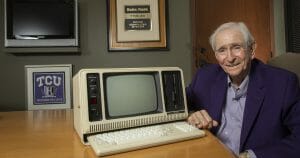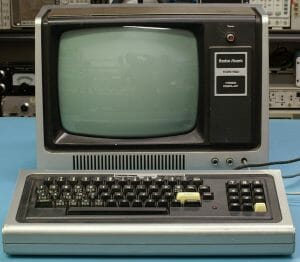Born in rural Texas, the Roach family moved to 150 miles east to Fort Worth when John was 4 — and he pretty much never left, not counting a stint in the U.S. Navy. He graduated from Texas Christian University there, majoring in physics and math, and returned two years later for his MBA, which he received in 1965. That’s when he got interested in computers. In 1967, Roach was hired by Tandy Corp. as its data processing manager. “At that time,” he said later, “neither the concept nor the thought of a personal computer had even been conceived.”

Fort Worth-based Tandy started as a leather craft company, but in 1963 Charles Tandy branched out in a wild way: he bought out a small, failing electronics chain called Radio Shack. Roach had ideas about where the new “home computer” market was going: the Apple 1 had hit the market in April 1976. Employee Don French showed Roach the MITS Altair computer kit he had bought. Roach wasn’t impressed, and had a team come up with something better — full-built, not a kit. In January 1977, Roach team took their idea to CEO Charles Tandy and Radio Shack president Lewis Kornfeld: a box of electronics with a full-size embedded keyboard, a TV set as a monitor, and a cassette tape player for program storage. He called it the “TRS-80” (for Tandy Radio Shack, and its Z80 microprocessor). “Charles blew a little smoke,” Roach recalled later, “and said, ‘Build a thousand and if we can’t sell them, we will use them in the store for something’.” Roach countered with 3,500 — one for each Radio Shack store. The computers finally hit the market in September 1977: the company “shipped 5,000 that year,” Roach said. But only that many, because it was “all we could assemble.” They cost $599.95, vs the Apple I at $666. The software for the machine came from a struggling startup: Microsoft.

That was probably part of the success of the TRS-80 Model I: the company manufactured it itself. Once it geared up it could produce 18,000 machines per month. The first model sold 55,000 in its first year, and over 200,000 during the its lifetime. An incompatible Model II soon followed. By 1978 Tandy promoted itself as “The Biggest Name in Little Computers,” and by 1979 needed 1,600 employees in six factories just to build computers. Charles Tandy died in November 1978; Roach was promoted to president in 1981, and CEO in 1983. He retired in 1999. Roach “helped create a market that so many people and companies benefited from as the personal computing industry took shape,” said Bill Gates. “John’s vision and his ability to get early computers, like the TRS-80, into people’s hands through Radio Shack made him one of the true pioneers of this industry.” John Vinson Roach II died in Fort Worth on March 20 from diabetes. He was 83.
